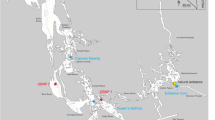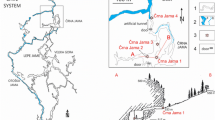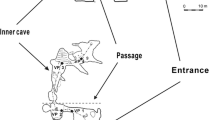Abstract
In Postojna Cave, air temperature and pressure monitoring has been conducted since July 21, 2008. Air pressure in the cave at three monitoring sites fluctuates synchronically with outside air pressure. Temperature data for Postojna 1 and 3 show good correlation with outside climate conditions for the period 2009–2010. The temperature at Postojna 1 was increasing constantly from March to May 2009, while at Postojna 2, it was decreasing. Postojna 1 has a seasonal trend in accordance with outer trend, while seasonal trend at Postojna 2 is just contrary to outside trend. Microclimate studies at Postojna 2 show local variability, especially in winter, and exhibit special microclimate conditions that may be due to ventilation of unknown passages in the back.























Similar content being viewed by others
References
Badino G (2004) Cave temperatures and global climatic change. Int J Speleol 33(1/4):103–114
Bourges F, Genthon P, Mangin A, D’Hulst D (2006) Microclimates of l‘aven d’Orgnac and other French limestone caves (Chauvet, Esparros, Marsoulas). Int J Climatol 26(12):1651–1670. doi:10.1002/joc.1327
Cropley JB (1965) Influence of surface conditions on temperatures in large cave systems. NSS Bull 27:1–10
Environmental Agency of Slovenia http://www.arso.gov.si/vreme/napovedi%20in%20podatki/postojna.html. Accessed 15 July 2010
Gams I (2003) Kras v Sloveniji v prostoru in času. ZRC Publishing, Ljubljana
Gosar A, Šebela S, Košťák B, Stemberk J (2009) Surface versus underground measurements of active tectonic displacements detected with TM 71 extensometers in Western Slovenia. Acta Carsologica 38(2–3):213–226
Hill T, Lewicki P (2010) Electronic statistics textbook. Tulsa, OK: StatSoft. http://www.statsoft.com/textbook/. Accessed 15 July 2010
Luetscher M, Jeannin PY (2004a) The role of winter air circulation for the presence of subsurface ice accumulations: an example from Monlesi ice cave (Switzerland). Theor Appl Karstol 17:19–25
Luetscher M, Jeannin PY (2004b) Temperature distribution in karst systems: the role of air and water fluxes. Terra Nova 16:344–350. doi:10.1111/j.1365-3121.2004.00572.x
Milanolo S, Gabrovšek F (2009) Analysis of carbon dioxide variations in the atmosphere of Srednja Bijambarska cave, Bosnia and Herzegovina. Bound Lay Meteorol 131:479–493. doi:10.1007/s10546-009-9375-5
Perrier F, Morat P, Le Mouël JL (2001) Pressure induced temperature variations in an underground quarry. Earth Planet Sci Lett 191:145–156
Perşoiu A, Feier I, Citterio M, Turri S, Maggi W (2006) Preliminary data on air temperature in Focul Viu ice cave (Bihor Mts, Romania). Proc 2nd Int Workshop on ice caves, pp. 62–64
Pflitch A, Piasecki J, Sawinski T, Strug K, Zelinka J (2006) Development and degradation of ice crystals sediment in Dobšinskà ice cave (Slovakia). Proc 2nd Int Workshop on ice caves, pp. 38–49
Pflitsch A, Piasecki J (2003) Detection of an airflow system in Niedzwiedzia (Bear) Cave, Kletno, Poland. J Cave Karst Stud 65(3):160–173
Šebela S, Vaupotič J, Košťák B, Stemberk J (2010) Direct measurement of present-day tectonic movement and associated radon flux in Postojna Cave, Slovenia. J Cave Karst Stud 72(1):21–34. doi:10.4311/jcks2009es0077
Smithson PA (1991) Inter-relationships between cave and outside air temperatures. Theor Appl Climatol 44:65–73
Stoeva P, Stoev A, Kiskinova N (2006) Long-term changes in the cave atmosphere air temperature as a result of periodic heliophysical processes. Phys Chem Earth 31:123–128. doi:10.1016/j.pce.2005.05.001
Acknowledgments
The study was performed within the projects Expert control and recommendations for management of cave systems and Climatic and biologic monitoring of cave systems financed by Turizem KRAS Destinacijski management d.d. It is also part of Karst Research Programme (P6-0119) and project Monitoring and analysis of selected climatic parameters in karst caves: The case of Postojna Cave system (L6-2156) both financed by Slovenian Research Agency. Ira D. Sasowsky (University of Akron, OH, USA) is thanked for comments of the manuscript. Suggestions of reviewers significantly improved the original manuscript.
Author information
Authors and Affiliations
Corresponding author
Rights and permissions
About this article
Cite this article
Šebela, S., Turk, J. Local characteristics of Postojna Cave climate, air temperature, and pressure monitoring. Theor Appl Climatol 105, 371–386 (2011). https://doi.org/10.1007/s00704-011-0397-9
Received:
Accepted:
Published:
Issue Date:
DOI: https://doi.org/10.1007/s00704-011-0397-9




